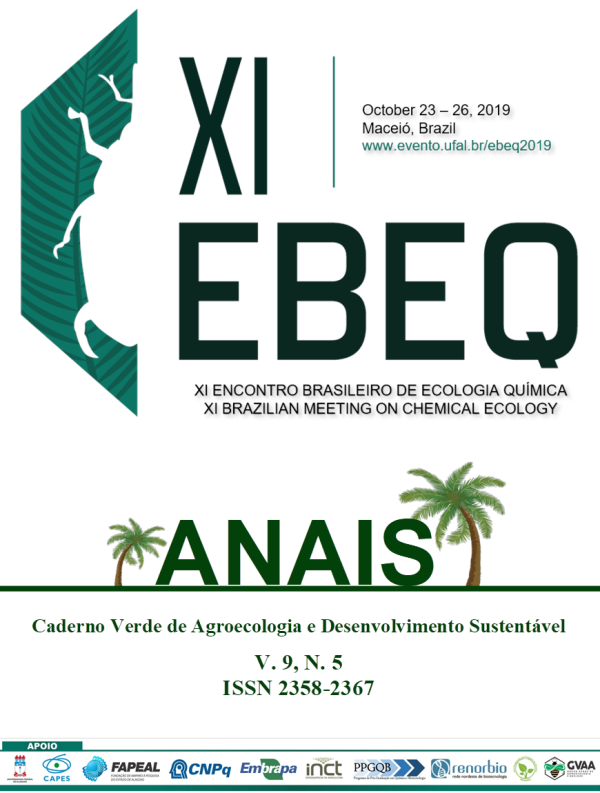IMPACT OF TRAP DESIGN FACTORS AND DEPLOYMENT METHODOLOGY ON THE PERFORMANCE OF SEMIOCHEMICAL-BAITED INTERCEPT TRAPS FOR FOREST Coleoptera.
Resumo
Surveys of forest insect pests attempt to monitor populations by sampling the insect or quantifying the damage they cause. Those surveys that target the adult stage of an insect often use semiochemical-baited flight intercept traps. The development of survey and detection programs for forest insects is currently a reactionary trial-and-error process because of unexplained variation in trap design and deployment effects and a lack of consensus in the literature regarding trap performance among taxa and habitats. This approach is costly both in terms of the time required to develop and optimize survey tools and the amount of damage realized before management programs can be implemented. This talk will focus on: 1) the effect of trap design factors on the abundance and diversity of forest insects captured by intercept traps and potential underlying mechanisms; and 2) the impact of trap deployment protocol on intercept trap performance. Field trapping experiments were used to examine the impact of intercept trap design factors on the abundance of target taxa and the diversity of forest Coleoptera captured. A meta-analysis of the available literature of trap design effects observed similar patterns of trap design effects on the capture of forest Coleoptera. It also observed a significant amount of heterogeneity in the effects of these factors that was only partially explained by variation among guilds and families. To begin to develop a mechanistic understanding of trap design effects a field trapping experiment examined the impact of trap silhouette by comparing captures of forest Coleoptera in white, black and clear intercept traps. Trap silhouette effects varied among taxa; more apparent traps captured more individuals in some but not all species. In an attempt to explain variation in the capture of Cerambycidae among four intercept trap designs, CO2 was used as a surrogate semiochemical and the flow of CO2 from each trap design was measured. Although plume structure differed downwind of the four trap designs, the observed differences in plume structure were not consistent with differences in trap captures. Field trapping experiments demonstrated that trap placement along environmental gradients (both edge-interior and canopy-forest floor) effects trap performance and that effects are variable among species. Although considerable progress has been made in recent years, we still have an incomplete understanding of how trap design and deployment effects vary among forest insect taxa and habitats. Future work should continue to document patterns of effects among taxa and habitats and attempt to determine underlying mechanisms. In the absence of a more complete understanding of patterns of effects and the contributing mechanisms, the development and optimization of survey and detection tools for forest insects will remain a costly trial-and-error process.Downloads
Publicado
Como Citar
Edição
Seção
Licença
Termo de cessão de direitos autorias
Esta é uma revista de acesso livre, em que, utiliza o termo de cessão seguindo a lei nº 9.610/1998, que altera, atualiza e consolida a legislação sobre direitos autorais no Brasil.
O(s) autor(es) doravante designado(s) CEDENTE, por meio desta, publica a OBRA no Caderno Verde de Agroecologia e Desenvolvimento Sustentável, representada pelo Grupo Verde de Agroecologia e Abelhas (GVAA), estabelecida na Rua Vicente Alves da Silva, 101, Bairro Petrópolis, Cidade de Pombal, Paraíba, Brasil. Caixa Postal 54 CEP 58840-000 doravante designada CESSIONÁRIA, nas condições descritas a seguir:
O CEDENTE declara que é (são) autor(es) e titular(es) da propriedade dos direitos autorais da OBRA submetida.
O CEDENTE declara que a OBRA não infringe direitos autorais e/ou outros direitos de propriedade de terceiros, que a divulgação de imagens (caso as mesmas existam) foi autorizada e que assume integral responsabilidade moral e/ou patrimonial, pelo seu conteúdo, perante terceiros.
O CEDENTE mantêm os direitos autorais e concedem à revista o direito de divulgação da OBRA, com o trabalho simultaneamente licenciado sob a Licença Creative Commons do tipo atribuição CC-BY.
O CEDENTE têm autorização para distribuição não-exclusiva da versão do trabalho publicada nesta revista.
O CEDENTE têm permissão e são estimulados a publicar e distribuir seu trabalho online (ex.: em repositórios institucionais ou na sua página pessoal) a qualquer ponto antes ou durante o processo editorial, já que isso pode gerar alterações produtivas, bem como aumentar o impacto e a citação do trabalho publicado.










